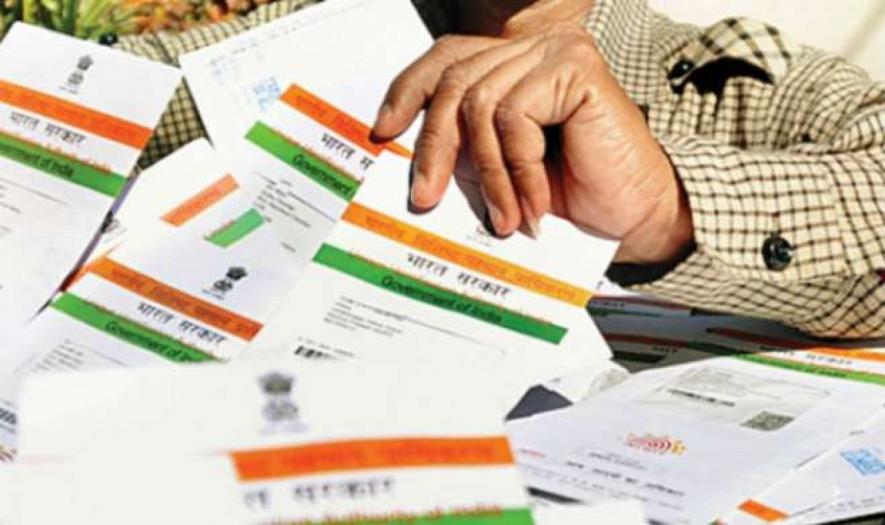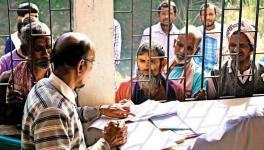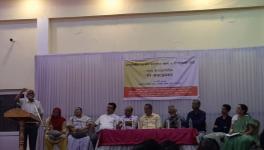Aadhaar Verdict: Supreme Court’s Vote of Confidence Against the Poor

Why should the poorest citizens of India go through a mandatory body-based (biometric) authentication to prove their identity — every single time they want to access their essential and legally mandated entitlements under the country’s welfare schemes -- and many a times get excluded? And, why should the Supreme Court think that this is justified?
On September 26, 2018, the five-judge Constitution Bench deliberating the constitutional validity of the Aadhaar project and the Aadhaar Act 2016 — both of which had been challenged on various grounds — delivered its much-awaited final verdict.
And the bench — in the prevailing majority opinion of 4:1 — held both the Aadhaar project and the 2016 Act as constitutional — albeit with modifications in some parts of the Act, which ostensibly limited the use of Aadhaar data by private parties to a certain extent.
But the bench upheld Section 7 of the Aadhaar (Targeted Delivery of Financial and Other Subsidies, Benefits and Services) Act, 2016, as “constitutional”.
Section 7 Woes
Section 7 of the Aadhaar Act makes it mandatory for beneficiaries of any service, benefit or subsidy under India’s welfare schemes to undergo Aadhaar-based biometric authentication or to at least furnish proof of possession of Aadhaar — the 12-digit biometrics-linked Unique Identification (UID) number — in order to avail of the benefit.
Moreover, at least 139 notifications issued under Section 7 have made Aadhaar mandatory — to the exclusion of any other identity proof — for availing nearly all existing schemes and services run by the central government, including ration through the Public Distribution System, social security pension, MGNREGA, etc.
Why is mandatory Aadhaar-based biometric authentication a problem when it comes to availing basic welfare schemes?
Because it has caused large-scale exclusions and denials of benefits — as overwhelming evidence suggests.
Justice DY Chandrachud was the sole dissenting judge on this matter — just as he was on other aspects of the Aadhaar project and the Act, both of which he held as unconstitutional.
However, the majority judgement seemed to have bought the BJP-led NDA government’s argument that Aadhaar was indispensable to effective delivery of welfare schemes by plugging “leakages” in delivery due to identity fraud.
This is despite the fact that these claims by the Modi government about Aadhaar weeding out “ghost” beneficiaries and saving huge money for the exchequer have been proven to be bogus again and again. In fact, it was even found that the UIDAI had apparently been fudging numbers.
And the Modi government has stuck to this argument in court — in the face of evidence of the large-scale problems and outright exclusion that Aadhaar-based biometric authentication has caused to people trying to access their basic rights like food and pension.
But as Justice Ashok Bhushan concluded in his judgement:
“Section 7 of the Aadhaar is constitutional. The provision does not deserve to be struck down on account of denial in some cases of right to claim on account of failure of authentication.”
The bench clearly did not consider the denials of benefits significant enough to warrant delinking of Aadhaar.
“When such scheme of Government is implemented, it is not uncommon that there may be shortcomings and some denial,” said Justice Bhushan.
“There is no material on record to indicate that as compared to non-receipt of eligible beneficiaries prior to enforcement of the Act, there is increase of failure after the implementation of the Act. It cannot be accepted that few cases of exclusion as pointed out by the petitioners makes Section 7 itself arbitrary and violative of Articles 14 and 21.”
He said the government and the UIDAI should address the denials of benefits — as they were empowered to do under the Aadhaar Act by framing rules and regulations — as it was a “serious” issue.
Now, there are a variety of factors that are causing the denials — but all of them basically have to do with the fact that the poorest of the people are being asked to negotiate technology for fulfilling their basic needs, like food.
Mandatory Aadhaar has created hurdles for beneficiaries at all stages, from failure in biometric enrolment itself to mismatch in fingerprints or even the iris at the time of verification for receiving the service.
Middle Class Spared
Why is it that the middle classes and above have not been required to give their fingerprint or iris scan to establish their identity each time they make a bank transaction, for example?
Because the UIDAI in April had admitted a biometric authentication failure rate of 8.54% when it came to iris scans and a failure rate of 6% with fingerprint scans.
The petitioners in the Supreme Court had argued that fingerprints not matching is a major problem especially for senior citizens and manual labourers.
During the SC proceedings, a 2012 report of UIDAI was cited where it said that biometric accuracy — after accounting for the biometric failure to enrol rate, false positive identification rate, and false negative identification rate — was 99.768%.
As the petitioners had argued, this percentage means that out of a population of more than 119.22 crore, there are 27.65 lakh people not receiving their benefits.
In court, the UIDAI had earlier submitted that senior citizens had a 95% acceptance rate when only fingerprint or iris scan was used, while the acceptance rate reached 99% when both were used.
And now the September 26 judgement has ruled that Aadhaar linking is not required for bank accounts, mobile connections, nor can Aadhaar be made mandatory for admissions to educational institutions and entrance exams. The majority judgement, however, did not clarify what will happen to the accounts and numbers already linked.
But the question remains — given the widely known unreliability of biometric software, why is it that it has been made mandatory in Fair Price Shops, but not in bank accounts? Does the government think the stakes are obviously lower with the poor?
The Right to Food Campaign has been consistently highlighting how Aadhaar has resulted in violations of the Right to Food, and had earlier issued a statement pointing out the massive exclusions due to linking of Aadhaar to everything from PDS, pensions, mid-day meals, MGNREGA wages, and nearly all other social welfare schemes and benefits.
There have been several other studies and reports of the devastation caused by Aadhaar linkage to the beneficiaries of welfare schemes, such as those by civil society group Mazdoor Kisan Shakti Sangathan and economist Jean Dreze.
Reports continue to pour in regularly about people being denied their entitlements and even dying for not getting ration/pension — either because of biometric failure, or because they did not have Aadhaar due to some problem or the other in enrolment, or for not linking it to the scheme in question.
For example, the 11-year-old girl in Jharkhand who starved to death to the old and infirm dying after pensions were denied — all due to Aadhaar-related problems. Then there are reported cases of the Point of Sale (POS) machines not working in areas with poor or no internet connectivity, no electricity to charge the machines, etc.
Activists, civil society groups and political parties that have been opposing Aadhaar, especially it being bulldozed over the poorest of our population, condemned the verdict.
‘Exclusion In-built Aadhaar Ecosystem’
Economist Reetika Khera, who is a part of the Right to Food Campaign, called the judgement disappointing because “the majority opinion provides little relief to the poor from Aadhaar (under Section 7), in terms of accessing essential entitlements. On this, it is disappointing that the judges who have signed the majority opinion have believed the government’s false assurances that nobody will be denied their entitlements due to Aadhaar.”
“We know that the governments have been blatantly violating the Supreme Court’s orders since 2013, and in its present form, exclusion is built into the Aadhaar ecosystem,” Khera said.
The Communist Party of India (Marxist) also issued a statement against the upholding of Section 7 of the Aadhaar Act.
“The reality is that lakhs of poor are being denied universal rights in the name of non-authentication of Aadhar. This renders vulnerable crores of poor people whose existence is dependent upon the accessibility to welfare schemes. Unfortunately, the majority judgment of the Supreme Court continues to maintain Aadhar as mandatory,” said the CPI(M).
“The Supreme Court’s so-called safeguards will prove to be ineffective. The benefits for the poor and marginalized sections can only be reached if Aadhar is explicitly made non-mandatory. The CPI(M) will continue its struggle on this score.”
So can the Aadhaar verdict be interpreted to mean that only the middle classes and above can be trusted?
Get the latest reports & analysis with people's perspective on Protests, movements & deep analytical videos, discussions of the current affairs in your Telegram app. Subscribe to NewsClick's Telegram channel & get Real-Time updates on stories, as they get published on our website.
























